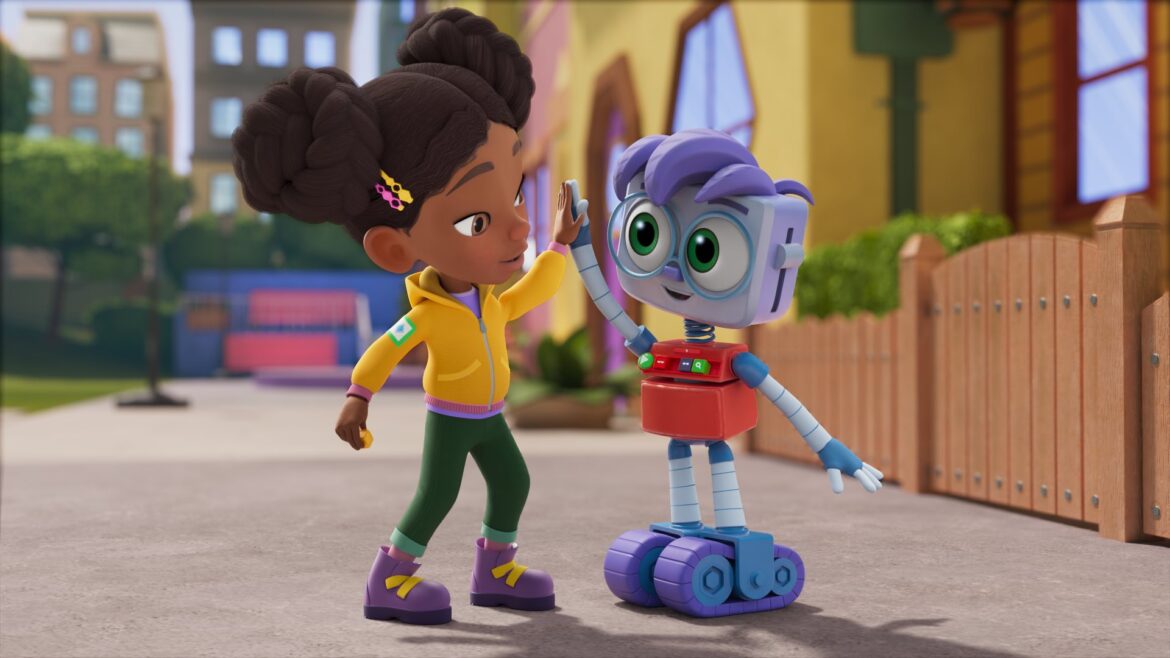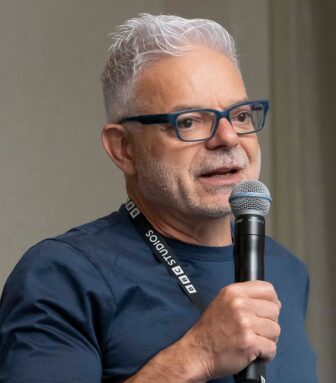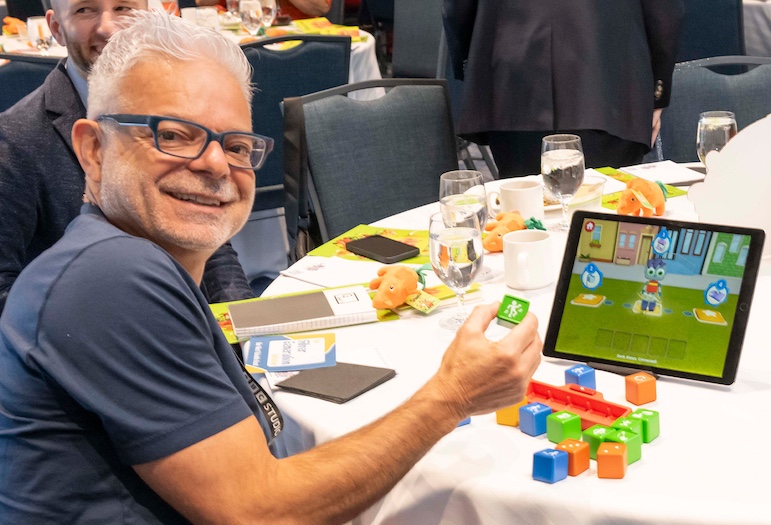New preschool series aims to teach coding skills

Mia, an eight-year-old coding whiz, and her "bro-bot" Codie.
To teach someone a dance, you break it down into a series of moves, like, “Step left, step right, spin around, repeat.”
With Mia & Codie, a new preschool series that aims to teach the basics of coding, takes a similar approach. Mia, an almost 8-year-old coding whiz, breaks down the steps for riding a bike or playing hide-and-seek for her “bro-bot” little brother Codie. In stackable 15-minute episodes of their adventures and mishaps, Mia schools Codie — and viewers at home — on sequencing, computational thinking and how to problem-solve.
Created by WordWorld producer Don Moody, Mia & Codie began national distribution through American Public Television’s Exchange service this month. The show, which debuted its first season on Canada’s TV Ontario last year, has lined up carriage commitments from public TV stations covering about 80% of U.S. television households, according to APT. Most stations plan to begin airing the 14 episodes by June.
In an episode about knowing when to stop, “Balloons, Balloons, Balloons,” Codie becomes so enamored with the act of blowing up a balloon that he asks Mia to help him do it again. She does this by adding a “loop” command to his code. The pair are lifted into the sky by an enormous bouquet of colorful balloons. To bring them back to safety, Mia stops the unchecked loop and reprograms Codie to use his pointy party hat to pop the balloons, one at a time, using another “loop” command. The pair make it back to Earth having learned both the danger of over-doing things and the value of debugging code.
‘Literacy of the future’
More than a decade in the making, Mia & Codie is built around an approach to early childhood education that Moody first developed with WorldWorld, an Emmy-winning PBS Kids that his company produced with WTTW in Chicago. That show, which debuted in 2007, used the building blocks of language to teach kids how to read. Eventually airing in over 100 countries around the world, WordWorld was funded in part by a Ready to Learn grant from the U.S. Department Of Education.
The show was so successful at teaching kids to read that the education department enlisted Moody to travel the country and talk to educators and interested parties, Moody says. He credits a conversation with Mitch Resnick, a computer scientist and learning expert who created a coding language for kids called Scratch, for sparking the idea for Mia & Codie. During a 2009 stop at the Massachusetts Institute of Technology, Moody recalls how Resnick challenged him to “do for coding what you’ve done for reading,” arguing that learning to code is the “literacy of the future.”

Moody held on to the idea but didn’t start working on it in earnest until 2015 — then it took three years to come up a concept he felt kids could understand. Fleshing out all the elements of that — the curriculum and coding language plus research and development of the TV show — involved nearly four years of additional work. All of this was before fundraising, which landed backing from Shaw Rocket Fund, an equity investor in Canadian children’s media, among other funders. After 18 months of production, Mia & Codie debuted on TV Ontario in March 2024.
Moody believes the show fills a big gap in K-12 curriculum, citing a recent report that found completing just one computer science course during K-12 education improves students’ earning potential by at least 8% by age 24. The study, from a big-tech backed education nonprofit that advocates for computer science and artificial intelligence as core to K-12 education, notes that only 60% of public high schools offer such a course — and only 6.4% of students enroll in them annually.
‘A-ha! moment’
When Moody started to work out the beats of what Mia & Codie would become, he decided to focus on preschool kids, since learning any new language is easier for young children. He also researched the available curricula and determined that most of the coding instruction for children was “too cerebral,” meaning it had no characters or stories behind it.
To really make coding lessons land, Moody says, he had to tie them to socioemotional learning. That combination would give the show both the impact and the penetration necessary to reach children across all markets and backgrounds.
Moody believes in what he calls a breakthrough moment in reading, when children really start understanding the language and concept. He was able to teach this with WordWorld, he says.
In thinking about what that “a-ha moment” could be for the show that became Mia & Codie, Moody remembered testing for WordWorld in which kids as young as 2 were given phones and asked to tell stories using emoji. They ably handled the challenge, which involves what Moody called “familiar icon recognition” — essentially the ability of 2- and 3-year-olds to understand images like emoji, app icons, and pictures of food or toys as part of early visual communication.
That’s why, on Mia & Codie, Mia teaches Codie basics of coding through what are essentially emoji blocks. Together, they build sequences of icons that teach everything from swinging on the playground to making s’mores and driving a go-kart.
Each five-minute segment of Mia & Codie takes a big idea and breaks it down into smaller component blocks, not unlike how WordWorld taught kids how to read.
“I was shocked, once we got into it, at how much we could teach at a very basic level,” Moody says. “Just the fact that we’re teaching sequencing, iconography, and looping at a preschool level is already a phenomenal breakthrough. Most people think kids have to wait until they can competently read to learn to code, and that’s not true. They just have to be competent thinkers.”
Learning how their world works
Moody enlisted a team of experts to help craft the show’s instructional methods, including Scot Osterweil from the MIT Game Lab, who helped figure out the show’s coding process on a macro level, and linguistics expert Chris Hancock, who used the show’s emoji characters to create a symbol-based language that producers call “Codium.” Game designer Jens Peter de Pedro, who helped create and launch the wildly popular children’s app Toca Boca, worked on Codium’s iconography; he’s also chief product officer for the Mia & Codie app.
Osterweil recalls being impressed by the storytelling in Mia & Codie. People had been working on ideas for kids’ programs that teach coding, including by using blocks, he says. But Mia & Codie takes the concept to a new level by connecting coding to a story, creating a “bridge between kids programming in their own lives and in their fantasy lives.”
Sparking kids’ imagination around programming also encourages them to “go further with it than if they were just doing it on an app,” Osterweil adds. The earlier children realize that computation is something they can master — whether through math, language or sequencing — the more likely they are to activate the part of their brain that enables them to build on what they learn.
Making coding easy for grown-ups too
Mia & Codie is also helping educators realize that they can learn coding. Or, rather, that coding might not be the C++ language of ones and zeroes that we all presume it to be.
Moody enlisted Dr. Natascha Crandall and a Canadian firm called OneFish, TwoFish to test the show with kids, as well as its corresponding app and a “phygital” block system that resembles Codie’s. Known as the “Codie Blocks Learning System,” the app and blocks wirelessly interact, allowing kids to practice computational thinking skills while sequencing their own runs of code. In the app, Codie replicates what players program on-screen, either in free-play mode or in one of the app’s 40 levels, which challenge players to help Codie complete a task. The app has already launched; the block system will become available in August.

Players can use the app without the blocks, but the manipulatable toy makes for a more tactile and tangible experience, especially for preschool children.
Researchers tested the show and its digital offshoots with children in public schools. They heard rave reviews — and not just from kids. A common response from teachers was, “If I knew coding was this easy, I would have brought it into my classroom sooner,” Moody says.
That feedback encouraged Moody and his partners to build out educational resources for Mia & Codie that reinforce socioemotional learning aspects of the stories and the coding that happens on-screen. The show’s website, still a work in progress, will also offer assessment tools for teachers to measure student progress, a coding “alphabet” that they can post in their classrooms plus downloads of PDFs and other unplugged activities.
Penny Bernath, educational services manager at South Florida PBS in Miami, watched Mia & Codie and realized that coding isn’t over her head. “I thought I could never do it,” Bernath says, “but now I feel like maybe if I took a class, I could give it a shot.”
A former preschool teacher, Bernath remembers using blocks to teach kids skills like putting things in order and matching. Mia & Codie is “the same kind of format,” she says. “I’m realizing sequencing and coding is just that, and I can see how easy it could be for a child to do.”
Bernath screened episodes when Joyce Belloise, SVP of content, was considering whether to pick up Mia & Codie. Bernath wanted to see whether the content was age-appropriate and meaningful. She believes it is.
APT is working with Moody to develop station partnerships that will provide educational materials from Mia & Codie to local school systems, according to APT’s Tom Davison, director of business development. “We really want to use the broadcast medium to teach kids, and we want kids to have the opportunity to learn these skills. But we also want to provide access to this more robust educational component that’s going to roll out along the way.”
Davison sees Mia & Codie as a “deeply thought-out opportunity” for schools that lack the resources or technology expertise to teach principles of coding. “The show is really spot-on for [APT],” he says, “but it’s also something we haven’t seen before, which is why we’re supporting it.”
So far, stations seem to agree, encouraging not just Davison but also Moody. He’s working on a second season of Mia & Codie, scheduled to drop as early as June.
“It’s a different world from ours out there with kids,” Bernath says. “With this generation, if you’re going to teach ABCs, it just feels like the natural next step would be for them to learn coding, because that’s what’s going to control information from here on out.”





